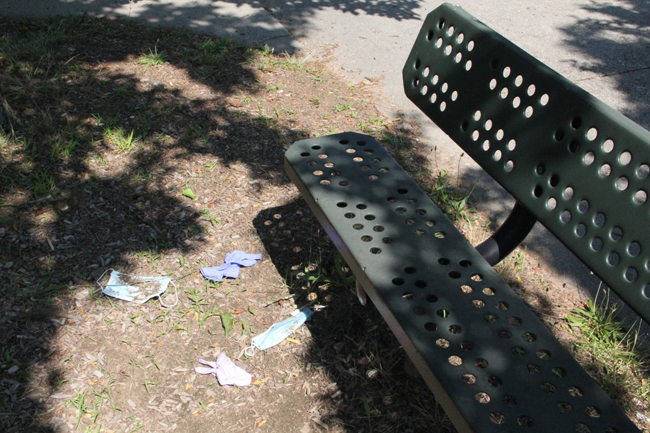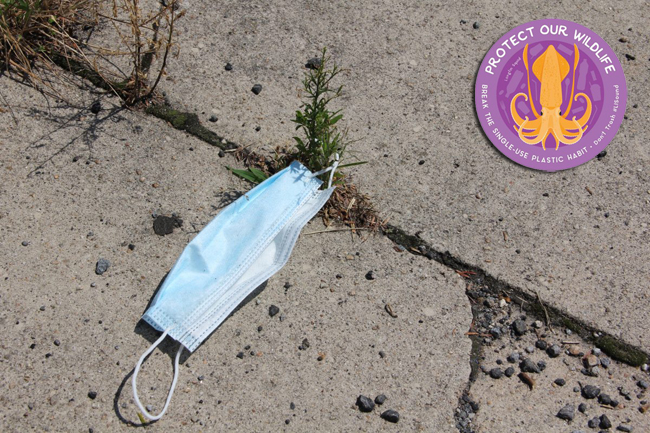
With face masks and other personal protective equipment ending up on sidewalks and other outdoor spaces, a seasonal campaign goes beyond encouraging citizens to break the single-use plastic habit by using reusable bags and bottles at the beach and local park. #DontTrashLISound reminds folks to discard #PPElitter in a secure trash can. Credit: Judy Benson / Connecticut Sea Grant
Contact:
Jimena Perez-Viscasillas, Long Island Sound Study Outreach Coordinator, E: jbp255@cornell.edu, P: (631) 632-8730
Stony Brook, NY, August 14, 2020 - Eight Million Metric Tons. That’s about how much plastic enters our oceans each year. Bottles, bags, take-out containers, and fishing lines to name a few items.
One of the focal points of this year’s #DontTrashLISound social media campaign is a problem that's grown during the COVID-19 pandemic: discarded face masks, disposable gloves and other personal protective equipment (PPE), which are ending up on sidewalks, parks and other outdoor spaces instead of in the trash.
"Our intent is to educate the Sound's residents about the dangers of plastic to wildlife, and about what we can do to help make this national estuary trash free," says Long Island Sound Study (LISS) Outreach Coordinator Jimena Perez-Viscasillas, a New York Sea Grant Cornell Cooperative Extension specialist based at Stony Brook University (SBU).
The fourth annual campaign, which this year runs for five weeks through September, includes messages on Facebook, Twitter and Instagram on what people can do to promote trash-free beaches and Long Island Sound, such as by reducing their use of disposable plastic bags and bottles. There are also quizzes being rolled out on Instagram to test the public’s knowledge on plastic’s impact on oceans, and posts about the COVID-19 related problem of PPE.

A popular "Protect Our Wildlife" stickers series continues this summer as part of the five week #DontTrashLISound educational campaign, which, in 2020, focuses on proper PPE disposal. Credit (for photo): Judy Benson / Connecticut Sea Grant
A new set of popular “Protect Our Wildlife” stickers are available as part of this year's #DontTrashLISound social media campaign. "We encourage residents to put a sticker highlighting a Long Island Sound animal on their reusable bottle and take a selfie at a Long Island Sound beach or park," says Perez-Viscasillas.
This year’s campaign builds on efforts over the last three years to encourage the public to be good stewards of the Sound by reducing single-use plastics and picking up trash on beaches that degrades the estuary for people and wildlife both. PPEs that end up on the ground instead of in the garbage can are likely to end up in streams, rivers and eventually the Sound. This problem was highlighted in a late July op-end article by Connecticut Sea Grant Communications Coordinator Judy Benson published in Connecticut Hearst newspapers.
"There are efforts being made to recycle the N95 face masks health care workers need, and some people are opting for homemade or commercially produced cloth masks that are washable," says Benson. "But many people are relying on synthetic fiber masks meant to be thrown out after just a few uses, and too many of these are being cast off in our public spaces. Or they’re being thrown in with recyclables where they don’t belong, passing along the task of proper disposal to the workers who sort the cans and bottles from the cardboard."
About three or four messages will be posted each week during the campaign, which is organized by LISS with support from the Connecticut and New York Sea Grant (CTSG and NYSG, respectively) programs, Mystic Aquarium, and other groups. Long Island Sound Study’s Citizens Advisory Committee will help spread the messages by sharing the posts on their own social media sites.
You can check out posts from the seven-week campaign using #DontTrashLISound on Twitter, Facebook and Instagram. And there's more information on the campaign at www.DontTrashLISound.net.
—some content in this article is provided by Long Island Sound Study and Connecticut Sea Grant
More Info: Long Island Sound Study
Long Island Sound is one of the 28 nationally-designated estuaries under
the NEP, which was established by Congress in 1987 to improve the
quality of Long Island Sound and other places where rivers meet the sea.
The Long Island Sound Study, conducted under the Environmental
Protection Agency’s (EPA) National Estuary Program (NEP), is a
cooperative effort between the EPA and the states of Connecticut and New
York to restore and protect the Sound and its ecosystems.
For more on what you can do to make a difference, click over to the "Get Involved" or "Stewardship" sections of the Long Island Sound Study's Web site. News on the Long Island Sound Study can also be found in New York Sea Grant's related archives.
If you would like to receive Long Island Sound Study's newsletter, please visit their site's homepage and sign up for the "e-news/print newsletter" under the "Stay Connected" box.
For daily updates and tips on how you can help protect and restore Long Island Sound, please join LISS on Facebook, Twitter or, sign up for their RSS feeds.
More Info: New York Sea Grant
New York Sea Grant (NYSG), a cooperative program of Cornell University
and the State University of New York (SUNY), is one of 34 university-based
programs under the National Oceanic and Atmospheric Administration’s
National Sea Grant College Program.
Since 1971, NYSG has represented a statewide network of integrated
research, education and extension services promoting coastal community
economic vitality, environmental sustainability and citizen awareness
and understanding about the State’s marine and Great Lakes resources.
Through NYSG’s efforts, the combined talents of university scientists
and extension specialists help develop and transfer science-based
information to many coastal user groups—businesses and industries,
federal, state and local government decision-makers and agency managers,
educators, the media and the interested public.
The program maintains Great Lakes offices at Cornell University, University at Buffalo, SUNY Oswego and the Wayne County Cooperative Extension office
in Newark. In the State's marine waters, NYSG has offices at Stony Brook
University in Long Island, Brooklyn College and Cornell Cooperative
Extension in NYC and Kingston in the Hudson Valley.
For updates on Sea Grant activities: www.nyseagrant.org has RSS, Facebook, Twitter, Instagram, and YouTube links. NYSG offers a free e-list sign up via www.nyseagrant.org/nycoastlines for its flagship publication, NY Coastlines/Currents, which is published quarterly. Our program also produces an occasional e-newsletter,"NOAA Sea Grant's Social Media Review," via its blog, www.nyseagrant.org/blog.